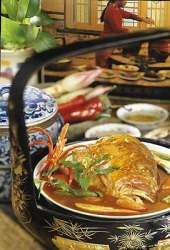The people of South-East Asian share a lot in common, the most obvious being their insatiable love of food. In conjunction with the upcoming 11th Asean Summit, REENA GURBAKSH finds out how what we eat more or less originates from one big cooking pot of indigenous tastes.
THE popular phrase mari makan, or let’s eat, has literal translations in more than half a dozen different languages in South-East Asia. Little wonder why, seeing that great food is easily found in all countries of the region, and that its people enjoy nothing more than tucking into a good meal.
The similarities don’t just end there either: Whether you’re tucking into a bowl of bun rieu (noodle soup) in Vietnam, kuytheav (broth with rice noodles) in Cambodia or mee sup in Malaysia, chances are there will be more than a handful of common ingredients that go into all those dishes.
This is because the countries of Asean – Brunei, Cambodia, Indonesia, Laos, Myanmar, the Philippines, Singapore, Thailand, Vietnam and Malaysia – have developed their cuisines through a combination of history, environment and culture. And while it may be easy to distinguish geographical boundaries between the nations, it is much harder to draw distinctions when it comes to lifestyle and food heritage.
“Each country shares a commonality in terms of climate. Warm weather and abundant rainfall allows the countries to grow rice,’’ says Julie Wong, editor of food and lifestyle magazine, Flavours (published by Star Publications Malaysia Bhd).
As a result, rice is a staple throughout South-East Asia, and it is normally eaten with fish or meat and vegetables: “We also grow similar vegetables and herbs and our proximity to sea coasts and rivers makes fish an important source of protein,’’ says Wong.
Many of the Asean countries have a history of colonisation by different Western powers – the Philippines by the Spanish, Indonesia by the Dutch, Vietnam by the French and Malaysia by the Portuguese, Dutch and British – who influenced the food the locals ate.
In Vietnam, for example, baguette sandwiches are very popular says Paul Liao, partner of the Sao Nam Vietnamese restaurants in Kuala Lumpur. “That’s what they eat when they want a light meal,’’ he adds.
However, Wong believes that the vast spice trade in the region prior to the colonial era introduced strong culinary influences from India and China that have had a much more distinct influence on our food preferences and eating habits.
From the first century up until the seventh century, ships travelled between China and India, with South-East Asia providing the ports in which to replenish supplies. From India, the traders sailed down the Malabar coast, then on to Burma and the Isthmus of Kra in Thailand, from where they transported their goods over land to Fu-nan (Cambodia), then to Vietnam, until they reached their final destination in China.
“The Indian influence is strong in countries like Burma, Malaysia, Indonesia and Thailand, whereas the influence from China is strong in Vietnam, Cambodia and Laos,’’ Wong says.
“In Myanmar, noodles are eaten as a snack and Mohinga, a spicy and soupy noodle dish is a favourite. Then, in the country’s Shan State, you’ll find something called Shan noodles which is made from sticky rice,’’ says photographer S.C. Shekar, who specialises in food photography and has travelled extensively in the region over the last 15 years.
Despite those generalities, many countries – ours included – are cook pots of influences from both countries. Sao Nam’s Liao says that although Vietnam’s cuisine has a distinct Chinese heritage, there are many dishes that have its origins from Indian cuisine, like Bahn Xeo – the Vietnamese version of a curry.
“You will also be able to find some form of curry (derived from the Tamil word karhi, meaning sauce) in all Asean countries, and this is eaten in either a mild or spicy form,’’ Shekar adds.
Internet food site sallys-place.com says that South-East Asian countries strongly influenced by India have ingredients such as cumin, coriander, ginger and caraway. This food site tells how the Arab traders who converted Java from Hinduism to Islam also left behind their culinary influence – kebabs, marinated meat cubes threaded on skewers, were reinterpreted to become satay, which now can be found all over Indonesia, Malaysia, Brunei, Singapore and has also become one of Bangkok’s favourite street foods.
Similarly, fruit and herbs indigenous to the region have spawned numerous interpretations and uses in different countries: Coconut milk is widely used in Indonesia, Thailand, Cambodia, Burma, Malaysia, Singapore, Vietnam, Laos and the Philippines.
Indonesia shares the flavours of lemon grass, galangal, kaffir lime leaf and pandan with Thailand, Malaysia and Brunei.
Shrimp paste and fish sauce add a unique flavour to the cuisines of the southern countries of the region, while fragrant herbs like coriander and galangal, also known as Thai ginger, is commonly simmered in soups, used to dress curries and added to salads for a burst of flavour.
Because much of these ingredients are fresh and readily available, the foods of the Asean region are also characterised by similar ways of cooking. Meats, fish and vegetables are often chopped into small portions and the most commonly used methods of preparing a meal are blanching, stir frying and steaming.
“Essentially, the cuisine of the region originated from street food. For the vendors, food had to be economical and time efficient, so cooking had to always be quick and easy,’’ quips Shekar.
Despite the methods and influences that have been adopted and indigenised by cooks in the region, the fact remains the flavours of South-East Asia are as diverse yet as intrinsically similar as its people.
A well-travelled foodie, C.M. Goh perhaps puts it most succinctly: “It is impossible to be homesick when you travel within South-East Asia … whether you crave for rice, curry or something spicy or sour, you can be sure that you’ll find it.’’

